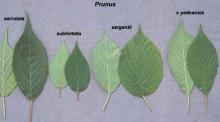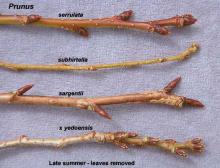Prunus serrulata
Common name:
Japanese Flowering Cherry
Oriental Cherry
Pronunciation:
PROO-nus ser-u-LA-ta
Family:
Rosaceae
Genus:
Synonyms:
Cerasus serrulata
Type:
Broadleaf
Native to (or naturalized in) Oregon:
No
- Broadleaf deciduous tree, 20-35 ft (6-11 cm), many clones, variable habits. Note horizontal lenticels on bark. Leaves alternate, simple, 5-13 cm long, have a long point, serrate with bristle-like teeth, 2-4 glands on petiole. Flowers 3.5 cm diameter, white, double, 3-5 per cluster, pedicels to 4 cm long. Fruit a small black cherry.
- Sun or part shade. Grown for the relatively large flowers that cover the trees in spring. Susceptible to several diseases.
- Hardy to USDA Zone 5 Species native to China, Japan, Korea.
-
Many cultivars have been developed, they apparently originated from hybridization between two or more wild species. Some of the more common cultivars include:
- 'Kanzan' - new leaves bronzy; flowers deep pink, double, 5 per pendulous clusters
- 'Mt. Fugi' - horizontal branch pattern; flowers white, semi-double, often turn pinkish before petal fall.
- 'Royal Burgundy' - leaves are purplish; flowers similar to 'Kanzan', but slightly darker pink
- 'Shiro-fugen' - leaves crimson flushed bronze when young, flowers small, double, pink in bud and white when open
- 'Shogetsu' - large, pure white flowers that are pink in the bud stage
- 'Ukon' - young leaves pale bronze, flowers semi-double, large, yellowish white or light green with pink center
- Cultivars are often grafted on to a rootstick of Prunus avium (wild or sweet cherry), but more recently on to Prunus serrula (Birchbark Cherry), at a height of about 5 ft to produce a tree with showy flowers and showy bark.
- serrulata: with small, saw-like teeth, a reference to the leaf margin
- Oregon State Univ. campus: south (west) side of the Memorial Union ('Mt. Fugi'); front of Bexell ('Kanzan').









